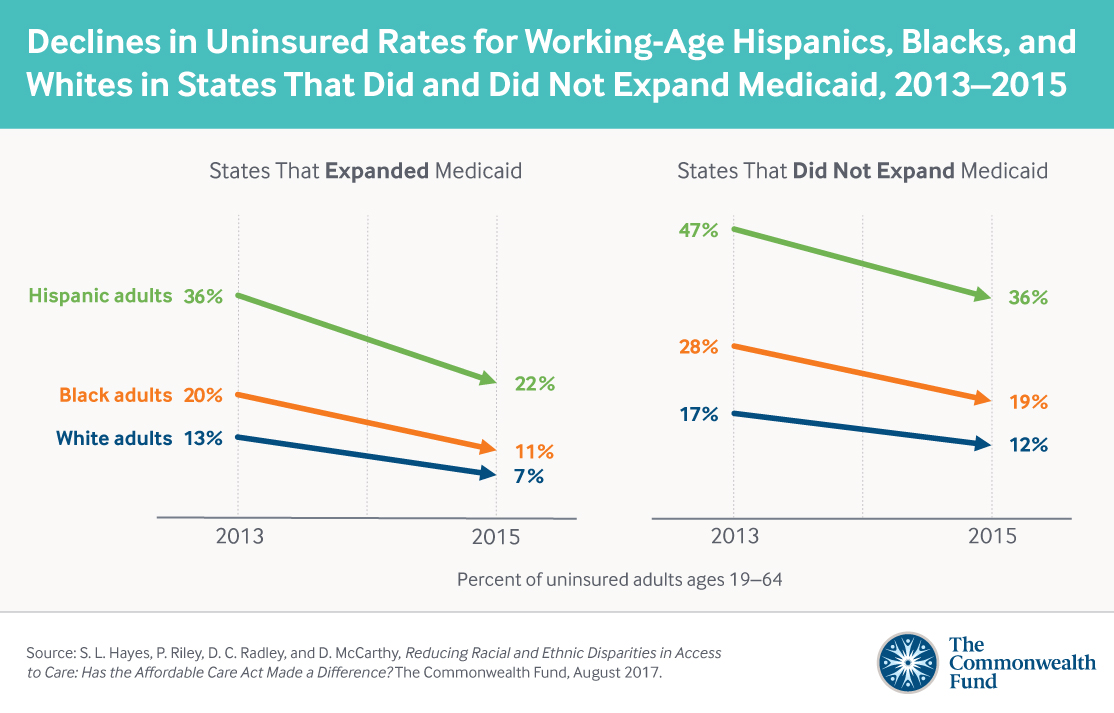New York, NY, August 24 — The disparities in health care access that blacks and Hispanics face compared to whites narrowed between 2013 and 2015, following implementation of the Affordable Care Act’s (ACA) major coverage provisions, according to a new Commonwealth Fund report.
While black and Hispanic adults still experience greater difficulty getting needed health care relative to whites, the historically wide gulf began to shrink after the ACA’s coverage expansions took effect. As a group, states that expanded Medicaid saw, on average, greater declines in racial and ethnic disparities on health care access measures than nonexpansion states did.

The report, Reducing Racial and Ethnic Disparities in Access to Care: Has the Affordable Care Act Made a Difference?, looks at three key measures of access through the lens of race and ethnicity: not having a regular source of care, not having insurance coverage, and going without needed health care because of cost. The analysis finds that between 2013 and 2015:
- Regular health care provider: The black–white disparity in the share of adults without a usual source of care has shrunken by nearly half, from eight percentage points to five points. The Hispanic–white disparity narrowed from 24 points to 21 points.
- Health insurance coverage: Among working-age adults who were uninsured, the black–white disparity narrowed by four percentage points, and the Hispanic–white disparity narrowed by seven points.
- Skipping needed health care: In terms of going without health care because of cost, the black–white disparity narrowed by two percentage points and the Hispanic–white disparity by three points.
"This analysis shows that the Affordable Care Act’s health insurance coverage provisions have helped the U.S. make progress toward ensuring that everyone, regardless of race or ethnicity, has access to the health care they need," said Pamela Riley, M.D., The Commonwealth Fund’s Vice President for Delivery System Reform and a coauthor of the report. "However, blacks and Hispanics are still much more likely than whites to be unable to get the health care they need. If we are going to reduce these disparities, we must continue to focus on policies like expanding eligibility for Medicaid that will address our health care system's historic inequities."
Overall, disparities shrank more between 2013 and 2015 in states that expanded Medicaid than in states that did not expand, especially for Hispanics:
- Regular provider: In Medicaid expansion states, the gap between Hispanics and whites narrowed by three percentage points, versus one point in nonexpansion states.
- Health insurance coverage: In expansion states, the gap between Hispanics and whites who were uninsured narrowed by eight percentage points, compared to six points in nonexpansion states.
- Skipping needed health care: In expansion states, the gap between blacks and whites in being able to afford needed health care narrowed by two percentage points, compared to one point in nonexpansion states.
ACA Improved Access to Health Care for Black and Hispanic Adults; Whites Still Do Better
According to the Commonwealth Fund report, blacks and Hispanics across the country made historic gains in their ability to access health care following the Affordable Care Act’s full implementation. Even states that did not expand Medicaid saw improvements, as people gained coverage through the health insurance marketplaces. Between 2013 and 2015, an estimated:
- 2 million more black adults and 3.5 million more Hispanic adults had health insurance;
- 2.4 million fewer black and Hispanic adults reported that cost prevented them from visiting a doctor when they needed to; and
- 3.8 million more black adults and Hispanic adults had a usual source of health care.
“It’s encouraging to see racial and ethnic disparities in access to health care narrowing,” said Commonwealth Fund President David Blumenthal, M.D. “Improving upon the Affordable Care Act, and expanding Medicaid in all states, will be critical if we are going to see disparities continue to shrink and ensure that everyone can get affordable, high-quality health care.”
Moving Forward
Despite the gains blacks and Hispanics have made, they still have a harder time than whites getting the health care they need and are more likely to be uninsured, skip needed health care because of cost, and go without a regular source of care. As Congress debates how to move forward with the Affordable Care Act and its health insurance marketplaces, the report’s authors say that it is important to keep in mind the millions of black and Hispanics for whom access to care improved as a result of the law.
MethodologyIndicators and Data Sources: Percent of uninsured adults ages 19–64. Source: Authors’ analysis of U.S. Census Bureau, 2013, and 2015 1-Year American Community Surveys, Public Use Microdata Sample (ACS PUMS). Percent of adults age 18 and older who went without care because of cost during past year and percent of adults age 18 and older who did not have a usual source of care. Source: Authors’ analysis of 2013 and 2015 Behavioral Risk Factor Surveillance System (BRFSS). For this analysis, survey respondents were stratified by their self-reported race or ethnicity: white (non-Hispanic), black (non-Hispanic) or Hispanic (any race). National averages were calculated for each of the indicators listed above, stratified by race/ethnicity. In addition, average rates were calculated for white, black, and Hispanic individuals in 2013 and in 2015 across two categories of states: The Medicaid expansion group included the 27 states that, along with the District of Columbia, expanded their Medicaid programs under the ACA between January 1, 2014, and January 1, 2015; the nonexpansion group comprised the 23 states that had not expanded Medicaid as of that time. Reported values are averages across survey respondents, not state averages. Subpopulation rates were suppressed if unweighted cell counts were less than 50. |


